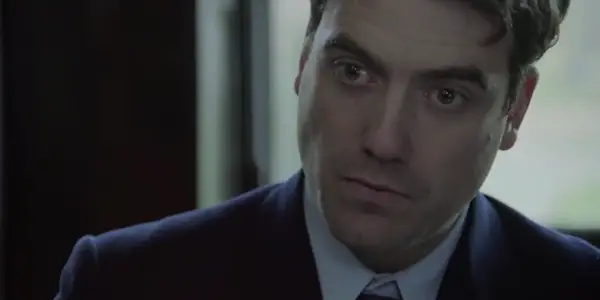SOMATIC: An Original Copy
I'm a writer, artist and teacher based in Manchester, England.…
Seemingly straight forward or a code that needs to be cracked? Somatic is a puzzle of a short film by director Will Nash that raises questions of replication and authenticity in both form and content. For a film exploring the notion of the copy, Somatic embodies a very original approach.
Making and Preserving History
It is the assertion of Dr Robert Briggs, at the outset of the film, that through cloning technology “we can make and preserve history”. Through a five part sequence, over ten minutes, something unfolds on the screen. Something. A semblance of documentary, models poised on the brink of stop motion, a medical consultation, an operation and the emergence of the patient from anesthetized slumber. The puzzle of the film is contained in the heading of this paragraph: is history being made or preserved here, as surely it can’t be both?
Yet in the way that Somatic is made, Nash is insisting that it can be both. Somatic explores cloning – a technique that is currently pioneering, and in practise at least some distance off achieving what is implied in the film – by using modern technology to replicate old outmoded forms of technology. To complicate things further, this futuristic tale is set in the past: in 1943. History is clearly documented as “being made”… but is it really preserved or is something similar created after the demise of the original?

This may sound like a pedantic distinction, but it’s the intellectual intrigue at the heart of this film and it’s why, despite the unanswered questions and loose ends, it is a pertinent and striking film that is very much of its time (the now, in case you’re confused!). Questions of identity of people, things, news and facts abound in the current climate to the extent where through the burgeoning virtual reality market, even the veracity of experience may be called into dispute. Increasingly, we inhabit a world of plurality, of versions of things that possess shades of authenticity difficult to ascertain depending on the context of the observer. When it becomes impossible to tell if we are living in the real or the simulated, then we are already in the maze of what the thinker Jean Baudrillard called The Simulacra.
Trying to Uncover the Truth
Dr. Robert Briggs speaks directly to the camera from the medical corps archives of 1943. It’s an analogue camera. Or rather, I suspect, a digital film where the flickering countdown, glitches, and intrusions on the print have been determined to give that low res, 1940s analogue feel. It works beautifully, as do Briggs’ mannerisms and paralysed expressions – a convincing and compelling performance by Daniel Ings. Dr. Briggs proclaims the success of cloning.
During the credits that follow next, we see the scenes of the next section depicted in static replica models of the military hospital and the characters within. The remainder of the film is foretold in these shots, meaning that the events are not replicated once, but twice, in miniature plastic and in the flesh. Bryan Samson plays George Watson, a Somme veteran lamenting the way the first world war affected his life through a medical consultancy with the same Dr. Briggs, now in glorious colour. He then receives some sort of procedure – we infer cloning – and a younger, healthier George Watson emerges from bed to gasp at his reflection. But the original young George is of course, long gone – he cannot be preserved, but in the world of Somatic, he can be recreated somehow.

There’s the rub: in what sense is this young George actually young George? Wickedly, the viewer does not get to find out. A good short film, like a good short story, should leave us wanting more; but it seems like here, we’ve been given just a taster and now we want the main event. In fact, there are so many intriguing and complex ideas just suggested in Somatic that it seems cruel not to explore the story further in a longer feature. It is at least a pleasant kind of torture.
A Conclusion: Film On Film
This is a film about making history, yet we seem compelled to try and emulate our old technologies with our new ones, as though digital media needs supplementing somehow to make it palatable. The young George is emulated…but will he be loved in the same old way? Or are we trapped in the past, in a time warp from which we can never advance?
Ultimately, this is a film about film that skilfully articulates that subtext without being overtly self-referential or smug. It’s a meditation on replication, the synthetic and the real, on authenticity and simulation. That’s the territory of film as a medium carved out into a 21st century stomping ground.
Philosophically, Somatic touches innovatively on themes of skepticism in the extent of one’s knowledge of the world and identity, as do classics such as Blade Runner and Inception – ultimately how can I be certain of anything?
So do the intricate leaps of the plot enable you to suspend your disbelief in cloning in the ’40s? Clones are not identical in their experience or their consciousness, so how exactly does the new young George recognise himself? Is Dr. Biggs a clone? Maybe we are all clones, replicants or possibly, as Robert Nozik once suggested, we are just brains in a vat we can never perceive. Let me know what you think in the comments below. Maybe we’re like-minded.
Does content like this matter to you?
Become a Member and support film journalism. Unlock access to all of Film Inquiry`s great articles. Join a community of like-minded readers who are passionate about cinema - get access to our private members Network, give back to independent filmmakers, and more.
I'm a writer, artist and teacher based in Manchester, England. My debut novel is entitled Look At What You Could Have Won and you can find extracts from it, along with my Anti-Reviews, original fiction written in response to art and cultural events, on my blog: This Is Not A Film Review.













